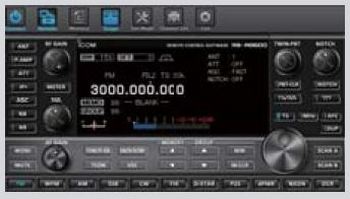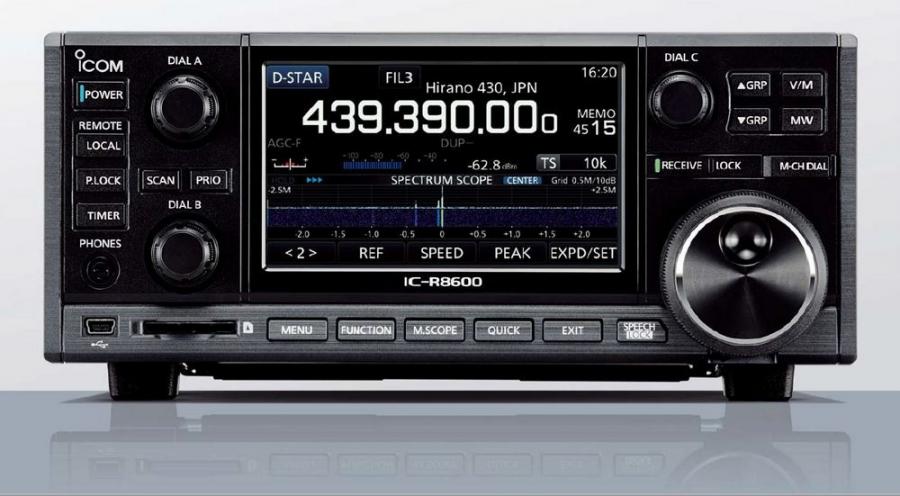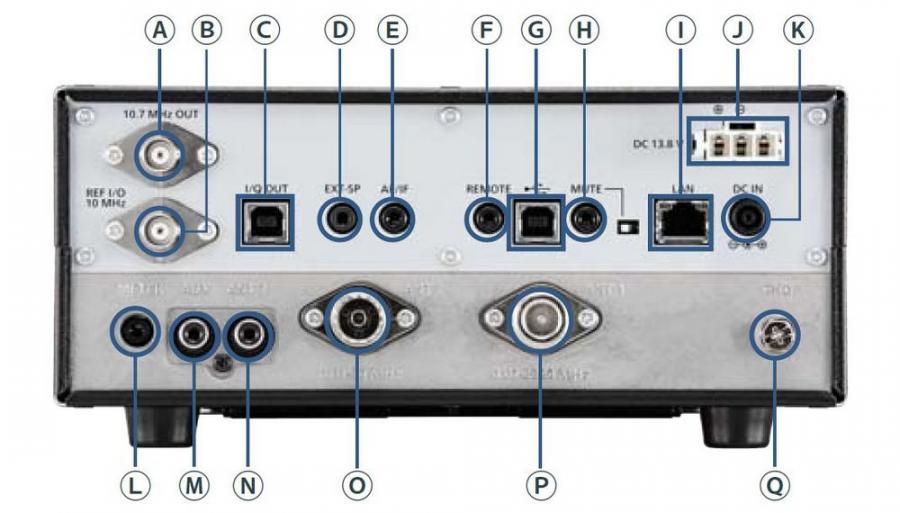ICOM IC-R8600 Communications Receiver
High Performance Software Defined Receiver
- 10 kHz - 3.0 GHz Super Wideband
- P25, NXDN™, dPMR™, D-STAR Mode
- Real-time Spectrum Scope with Waterfall
- Software Demodulation by FPGA Processing

Exciting Innovation in the Professional Communications Receiver World
The IC-R8600 is a super wideband 10 kHz to 3 GHz communication receiver that enables you to hear and see a wide variety of signals in various ways. Not only does it decode diverse digital communication signals, but the advanced FPGA processing technologies implemented provide clarity and accuracy of received signals. With the optional remote control software for a Windows® PC, received audio and spectrum scope data can be transferred through an IP network for monitoring from remote locations.
Superior Performance
10 kHz to 3 GHz Super Wideband Coverage
The IC-R8600 decodes various digital protocol signals including P25 (Phase 1), NXDN™, dPMR™, D-STAR, Japanese DCR (Digital Convenience Radio) as well as receives conventional analog signals such as USB, LSB, FSK, CW, AM, S-AM (Synchronous-AM), FM and WFM modes, covering 10 kHz to 3 GHz wideband in 1 Hz steps.
Absolute Value of RSSI (Received Signal Strength Indicator)
The IC-R8600 shows S-meter, dBμ, dBμ (emf) and dBm meter types in the RSSI. The dBμ, dBμ (emf) and dBm meter has a high ±3 dB accuracy* (between 0.5–1100 MHz) that can be used for measuring signal strength level.
*Less than ±6 dB between 1100–3000 MHz.
Software Demodulation in FPGA Processing
The IC-R8600 utilizes FPGA (Field Programmable Gate Array) and DSP units for demodulation, decoding and most of signal processing. Direct HF signals and intermediate frequency signals, which are converted from VHF/UHF signals, are digitized in a 14-bit A/D converter and transferred to the FPGA and DSP for optimal processing. The high-rate 122.88 MHz sampling frequency used for the A/D converter results in superior aliasing and image reception reduction
Superb Receiver Performance
The IC-R8600 has 11 discrete RF bandpass filters in the HF bands and 13 bandpass filters in the VHF/UHF bands. To prevent overflow, only the intended signal is passed, while any out of range strong interference signals are rejected. The IC-R8600 provides +30 dBm IP3 and 105 dB dynamic range at 14.1 MHz. IP3 performance is +10 dBm at 144 MHz and 0 dBm at 440 MHz.
Ample Memory Channels
The IC-R8600 has up to 2000 regular memory channels assignable to 100 groups. In addition to the regular memory channels, up to 100 scan skip channels and 50 pairs of program scan edges can be set. The auto memory write scan automatically stores busy frequencies in the auto memory write channels (up to 200 channels). These memory channels and various settings can be edited with the optional CS-R8600 programming software on a Windows® PC.
Variety of Scan Functions
A variety of scan functions effectively and thoroughly search for desired stations. The IC-R8600 scans up to 100 channels per second in the memory scan mode.
- Program scan/Fine program scan
- Δf scan/Δf fine scan
- Priority scan
- Memory scan
- Selected memory scan
- Selected mode memory scan
- Auto memory write scan
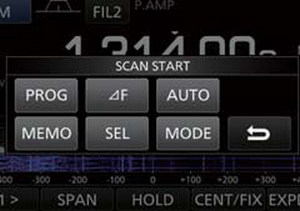
Scan setting screen
Intuitive Operation
Real-time Spectrum Scope with Waterfall Function
The high-resolution real-time spectrum scope provides class-leading performance in resolution, maximum 30 frames per second* fast sweep speed, ±2.5 MHz wide scope span (display range) and 110 dB of dynamic range (at ±2.5 kHz span). The waterfall screen allows you to find weak signals by showing the spectrum change over time. When tapping the spectrum scope or waterfall screen, the tapped area can be selected as the operating frequency. The peak search function finds several peak frequencies within the scope range, and helps you to select these. (* Approximate)
Quick, Smooth and Intuitive Operation
To efficiently acquire intended signals, the IC-R8600 user interface provides quick and accurate operation. The large 4.3-inch color display, with touch screen function, is configured to collect operating information. By tapping indications and icons on the screen, the setting menu will pop up and parameters can easily be adjusted. When either the DIAL A, B or C multi-function control knobs is pushed, various functions, such as scan speed, RF gain, audio tone, display backlight or other menus will pop up on the display.
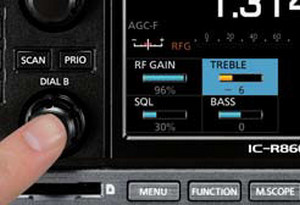
Pop up menu appears by pushing DIAL B
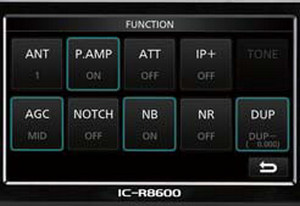
Functions menu for touch screen operation
Extensive Rich Features
SD Card Slot for Receiver Recorder
The recorder function can record received audio onto an SD card in WAVE format. The recorded voice audio can be played back on the receiver or a PC. When a 32 GB SD card is used, up to 270 hours of recording is possible. In addition, the screen capture function saves a snap shot of the screen in PNG or BMP format on the SD card.
* An SD card is required separately
Remote Control Function through IP Network or USB Cable
The optional RS-R8600 PC remote control software allows you to listen to received audio and control most of the receiver functions, including the spectrum scope, through an IP network or USB cable.
RS-R8600 screen
I/Q Signal Output
The I/Q signal output function* allows you to derive digital IF signals from the I/Q output jack. It can be used for analyzing spectrum or decoding signals.
* This function will be provided with future firmware update.
A third-party software may be required separately
Other Features
3 antenna connectors: an SO-239 type and a phono (RCA) connector for HF and a type-N connector • Clock and NTP function • Center tuning meter and digital auto frequency control (AFC) for FM, WFM and digital modes • Voice synthesizer function • Audio tone functions: HPF/LPF, bass, treble and de-emphasis • Decode multiple digital code used in digital mode • IP+ function improves 3rd order intercept point performance • Main dial friction adjustment • Dial lock and panel lock • CI-V remote control commands • RX history log for digital modes
Specifications
| GENERAL | ||||
| Frequency coverage | EUR | 0.010000–3000.000000 MHz* (*Working range) | ||
| FRA | 0.1357– 0.1378, 1.810– 1.850, 3.500– 3.800, 7.000– 7.200, 10.100– 10.150, 14.000– 14.350, 18.068– 18.168, 21.000– 21.450, 24.890– 24.990, 28.000– 29.700, 50.000– 52.000, 144.000–146.000, 430.000 –440.000, 1240.000– 1300.000, 2300.000–2450.000 MHz | |||
| Antenna connector | ANT 1 (0.01–3000 MHz): Type-N (50 Ω) ANT 2 (0.01–30 MHz): PL-259 (50 Ω) ANT 3 (0.01–30 MHz): RCA (500 Ω) | |||
| Frequency stability | Less than ±0.5 ppm (at 25˚C after warm up) | |||
| Mode | USB, LSB, CW, FSK, AM, FM, WFM, Digital (D-STAR, P25 Phase 1, NXDN, dPMR, DCR) | |||
| Number of channels | 2000 regular with 100 groups, 200 auto memory write, 100 skip and 100 scan edge channels | |||
| Scan types | Programmed, memory, selected memory, selected mode, auto memory write, priority scan and Δf scan | |||
| Power supply requirement | 13.8 V DC ±15% | |||
| DC current drain | Stand-by: 1.8 A, Maximum audio: 2.0 A | |||
| Operating temperature range | –10 ˚C to +60 ˚C | |||
| Frequency resolution | 1 Hz | |||
| Dimensions (W × H × D) (projections not included) | 220 × 90 × 230 mm | |||
| Weight (approximately) | 4.3 kg | |||
| RECEIVER | ||||
| Receiver system | ||||
| 0.010–29.999 MHz | Direct sampling | |||
| 30.000–499.999 MHz | Double superheterodyne (IF: 778.7, 46.35 MHz) | |||
| 500.000–1099.999 MHz | Double superheterodyne (IF: 278.7, 46.35 MHz) | |||
| 1100.000–1499.999 MHz | Triple superheterodyne (IF: 900–500.000001, 278.7, 46.35 MHz) | |||
| 1500.000–3000.000 MHz | Triple superheterodyne (IF: 1000–500, 278.7, 46.35 MHz) | |||
| Sensitivity for RED*1 (at 12 dB SINAD) | 1.8 MHz band | 3.5– 29.7 MHz bands | 50/70/144/430/1200/2400 MHz bands | |
| SSB (Less than, BW= 2.4 kHz) | 16 dBμV emf. | 0 dBμV emf. | –6 dBμV emf. | |
| AM (Less than, BW= 4 kHz) | 16 dBμV emf. | 6 dBμV emf. | 0 dBμV emf. | |
| FM (Less than, BW= 7 kHz) | - | 0 dBμV emf.*2 | –6 dBμV emf. | |
| *1 Guaranteed range for sensitivity is for amateur bands only. With CCITT filter ON *2 28–29.7 MHz | ||||
| Selectivity for RED*3 | More than | Less than | ||
| LSB/USB/FSK (BW: 2.4 KHz) | 2.4 kHz/–3 dB | 3.6 kHz/–60 dB | ||
| CW (BW: 500 Hz) | 500 Hz/–3 dB | 700 Hz/–60 dB | ||
| AM (BW: 6 kHz) | 6.0 kHz/–3 dB | 15.0 kHz/–60 dB | ||
| FM (BW: 15 kHz) | 12.0 kHz/–6 dB | 25.0 kHz/–60 dB | ||
| WFM | 180 kHz/–6 dB | |||
| *3 Guaranteed range for selectivity is for amateur bands only. | ||||
| Spurious and image rejection | (Analog mode operation) | |||
| 0.010–29.999 MHz | More than 70 dB | |||
| 30.000–1099.999 MHz | More than 50 dB | |||
| 1100.000–2499.999 MHz | More than 40 dB*4 | |||
| 2500.000–3000.000 MHz | More than 40 dB*4 | |||
| *4 More than 35 dB for 1st IF through above 1100 MHz. More than 30 dB for 1st IF image above 2000 MHz | ||||
| Audio output power | More than 2.0 W (8 Ω load, 10% distortion) | |||
All stated specifications are subject to change without notice or obligation.
Options
AH-8000 Super Wideband Omnidirectional Antenna
Frequency coverage: 100–3335 MHz
SP-39AD External Speaker with DC Power Supply
High quality audio and matching height
Speaker maximum input: 7 W, 8 Ω
Power supply output: 15 V/2 A
SP-23 External Speaker
4 audio filters; headphone jack.
Input impedance: 8 Ω
Max. input power: 5 W
AH-710 Folded Dipole Antenna
Covers 1.9–30 MHz bands.
AD-55NS Power Supply
Input: 100–240 V/1 A
Output: 15 V/2 A
- MB-123 Carrying Handle
- CS-R8600 Programming Software for Windows® PC
- RS-R8600 Remote Control Software for Windows® PC
Rear Panel View
| A - 10.7 MHz IF Output Jack B - 10 MHz Reference Frequency Input/Output C - I/Q Output Jack D - External Speaker Jack E - AF/IF Output Jack F - CI-V Remote Control Jack G - USB Connector H - MUTE Jack I - LAN (Ethernet) Connector | J - 13.8V DC Power Socket K - DC IN Jack (For use with AD-55NS or SP-39AD) L - S-meter Output Jack M - AUX Jack N - RCA Antenna Connector (HF: 500 Ω) O - PL-259 Antenna Connector (HF) P - Type-N Antenna Connector (HF/VHF/UHF) Q - Ground Terminal |



